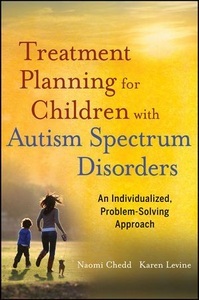



Chapter 1. Introduction: Looking at Treatment Planning Through a Different LensDefining Best PracticesMedia OverloadA New Way of Thinking about Autism TreatmentCore Deficits of Autism.How the Book is OrganizedWhy There is Confusion about EBP in Treating ASDChapter 2. What is Evidence Based Practice?What is So Important ?Common Errors in Evaluating TreatmentsHow Then Can Treatments be Evaluated?History of Evidence Based Practice in PsychologyBrief History of EBP as it Pertains to AutismEvolution and Expansion of EBPEBP as it Pertains to AutismClinical JudgmentAutism-Specific vs. Non-Specific TreatmentsThe Evolution of Treatment Models and TerminologyClient Voice in What to Treat and How to TreatWhat is Important to Study? What is Important to Treat?The Role Context in Treatment Selection:Positive and Negative Policy Implications of uses of EBP in Autism TreatmentsConclusions and RecommendationsChapter 3. The Individualized, Problem-Solving Treatment ProcessOur Beliefs and BiasesThe Role of Children's EmotionsThe Challenge of GeneralizationStrengthening Social ConnectionsStep 1: Gather Background InformationStep 2. Identify the ProblemStep 3. State the Hypothesis, Yours and Others'Step 4. Review ResearchStep 5. Design the Treatment PlanStep 6. Evaluate Effectiveness and Generate your own EvidenceStep 7. Redesign the Plan as NeededChapter 4. Jamal: A Previously Happy Preschooler DisengagesStep 1: Gather Background InformationStep 2.Identify the ProblemStep 3.State the Hypothesis, Yours and OthersStep 4.Review Treatment ApproachesStep 5. Designing the Treatment PlanStep 6.Evaluate Effectiveness and Generate Your own EvidenceStep 7: Redesign the Plan as NeededChapter 5. Katherine: A Nine Year Old Learns to Cope with Hew Own Explosive EpisodesStep 1: Gather Background InformationStep 2: Identify the ProblemStep 3: State the Hypothesis, Yours and Others:Step 4.Consider Treatment ApproachesStep 5.Design the Treatment PlanStep 6.Evaluate Effectiveness and Generate Your own EvidenceChapter 6. Brandon: Developmental Delays and OCD present a Big Challenge for a Non-verbal PreschoolerStep 1. Gather Background InformationStep 2. Identify the ProblemStep 3. State the Working Hypothesis, Yours and Others'Step 4. Review Treatment ApproachesStep 5. Design the Treatment PlanStep 6. Evaluate Effectiveness and Generate Your Own EvidenceStep 7. Redesign the Plan as NeededChapter 7. Raphael: A Happy, Well-Behaved Six Year Old Becomes Increasingly RigidStep 1. Gather Background InformationStep 2. Identify the ProblemStep 3. State the Hypothesis, Yours and Others'Step 4. Review Treatment ApproachesStep 5. Design the Treatment PlanStep 6. Evaluate Effectiveness and Generate Your Own EvidenceStep 7: Redesign the Plan as NeededChapter 8. Alex: Extreme Mood Dysregulation Interferes with School and Home Functioning for a Fourth GraderStep 1. Gather Background InformationStep 2. Identify the ProblemStep 3. State the Hypothesis, Yours and Others'Step 4. Review Treatment ApproachesStep 5. Design the Treatment PlanStep 6. Evaluate Effectiveness and Generate Your Own EvidenceStep 7. Redesign the Plan as NeededChapter 9. Emily: A Passive Teenager Begins to Learn Self-help SkillsStep 1. Gather Background InformationCoping with the Present - Worried about the FutureStep 2. Identify the Problem:Step 3. State the Hypothesis, Yours' and Others?Step 4: Review Treatment Approaches:Step 5. Design the Treatment PlanStep 6. Evaluate Effectiveness and Generate Your Own evidenceStep 7. Redesign the Plan as NeededChapter 10. Chen A teenager with Aspergers hits bottom, but with help and determination, heads for collegeStep 1. Gather Backgroun InformationStep 2. Identify the problemStep 3. State the Hypothesis, Yours and Others'Step 4. Review Treatment ApproachesStep 5. Design the Treatment PlanStep 6. Evaluate Effectiveness and Generate your own EvidenceStep 7. Redesign the Plan as NeededChapter 11. Michael, a 10 year old whose behaviors are becoming more and aggressive and disruptiveStep 1. Gather Background InformationStep 2. Identify the ProblemStep 3. State the Hypothesis, Yours and Others'Step 4. Review ResearchStep 5. Design the Treatment PlanStep 6. Evaluate Effectiveness and Generate your own EvidenceStep 7. Redesign the Plan as NeededChapter 12: Jake: A five year old who has responded well to FloortimeStep 1: Gather Background InformationStep 2. Identify the ProblemStep 3. State the Hypothesis, Yours and OthersStep 4. Review ResearchStep 5. Design the Treatment PlanStep 6. Evaluate Effectiveness and Generate Your Own EvidenceAfterwordAppendix A: Autism Treatment ApproachesReferences... Mehr
Wir senden Dir eine Email, sobald das Produkt zum gewünschten Preis erhältlich ist.


 Preis-Alarm
Preis-Alarm



















